Gone Fishin'
by Bob Brooke
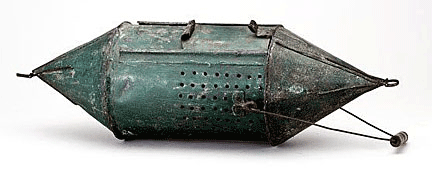 To
avid fishermen, fishing is an art form. And some antique fishing
equipment can be worth as much as a work of fine art. Such is the case
for split-cane fly rods and minnow buckets. To
avid fishermen, fishing is an art form. And some antique fishing
equipment can be worth as much as a work of fine art. Such is the case
for split-cane fly rods and minnow buckets.
Collecting fishing-related memorabilia has hit the big time. Though the
market is small compared to regular antiques, it, nevertheless, is a
lively one. The pastime of fishing has long had a variety of interesting
objects to collect. And one of the most interesting—and most obscure—is
the minnow bucket.
Minnow Buckets
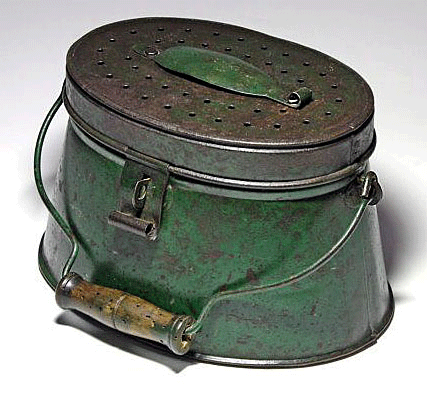 Keeping
bait alive is important for the fisherman. Early sporting goods
companies produced a variety of buckets, floats and other ingenious
devices for this purpose. While today's fishermen use state-of-the art
aerated buckets to keep minnows alive, fisherman of the 1880s had to be
more inventive. Keeping
bait alive is important for the fisherman. Early sporting goods
companies produced a variety of buckets, floats and other ingenious
devices for this purpose. While today's fishermen use state-of-the art
aerated buckets to keep minnows alive, fisherman of the 1880s had to be
more inventive.
One of the best minnow buckets made was the oval No. 1, made by the Hall
Manufacturing Company of Cinncinnati, Ohio in the 1880s. The largest
made, measuring 5˝ inches tall by 16 inches wide by 10 inches deep, this
innovative minnow bucket had a middle compartment for minnows and two
hinged end compartments for other baits or ice to keep the water cool.
It cleverly telescoped when two wing nuts were loosened and the inner
pail was pulled upward.

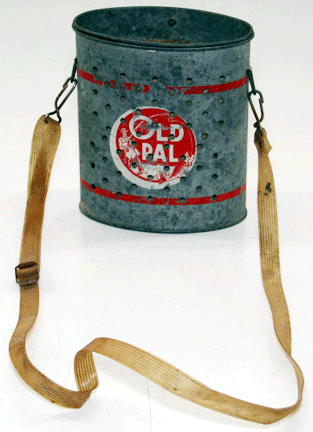 Hall
made five different styles of telescopic buckets. They came in a
japanned green finish or in oxidized copper on tin. The green japanned
No. 1 bucket originally sold for $3.90 and the copper version sold for
$4.50, both expensive at the time. A Hall No. 1 tin-plate bucket today
in very good condition sells for over $300 while the copper version
would be more than double that. Hall
made five different styles of telescopic buckets. They came in a
japanned green finish or in oxidized copper on tin. The green japanned
No. 1 bucket originally sold for $3.90 and the copper version sold for
$4.50, both expensive at the time. A Hall No. 1 tin-plate bucket today
in very good condition sells for over $300 while the copper version
would be more than double that.
Another unique early bait container is the Lucas No. 28L rectangular
floating bucket with a 10-quart capacity, measuring 11 inches high by
10˝ inches wide and 6 inches deep. Advertisements claimed that its shape
was more convenient to carry and more compact, thus taking up less room,
and a fisherman could carry it in a suitcase. The Lucas rectangular
bucket in a dark green japanned finish, with room for ice above the
insert liner, sells for over $400.
For those fisherman doing stream fishing, there were several styles of
trolling minnow floats—the Novelty Live Minnow Float, which held 10
quarts and measured 24 inches long by 77 inches in diameter and weighed
3˝ pounds, and the Hartford Minnow Float, made by Shinners-Russell
Company of Hartford, Wisconsin, which was 28 inches long by 7˝ inches
diameter and weighed 4 pounds. Designed to be trolled behind a boat,
they both had torpedo-shaped bodies with conical ends.
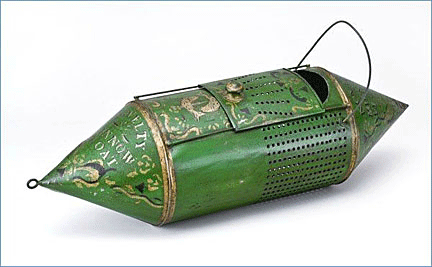 The
Hartford Minnow Float had air chambers at each end and a bottom ballast
to keep it right side up while being towed. Perforated in the rear to
aerate the minnows, it’s forward portion was not, which protected the
minnows while the fisherman trolled the float. The Hartford float sold
for $2.50 and was available from the late 1890s through 1920. In very
good condition, it now sells for $100 to $300. The
Hartford Minnow Float had air chambers at each end and a bottom ballast
to keep it right side up while being towed. Perforated in the rear to
aerate the minnows, it’s forward portion was not, which protected the
minnows while the fisherman trolled the float. The Hartford float sold
for $2.50 and was available from the late 1890s through 1920. In very
good condition, it now sells for $100 to $300.
Deshler Mail Box Co. of Deshler, Ohio, made the Jones Aquarium Minnow
Pails in B-and 12-quarts capacities from 1911 to 1937. These were "race
track" oval minnow buckets that contained an air chamber that you
pressurized with a bicycle pump. It forced a stream of air bubbles
through the water for four to six hours aerating the minnows and keeping
them alive and active. The air chamber also kept the Jones minnow bucket
afloat if the angler wished to use it in a lake or stream. They came in
a dark green japanned finish with striping and ornamental artwork. The
value of a Jones Aquarium Minnow Pail in very good shape is over $200.
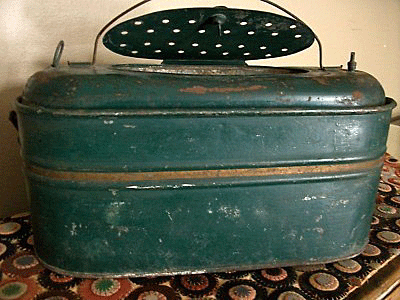
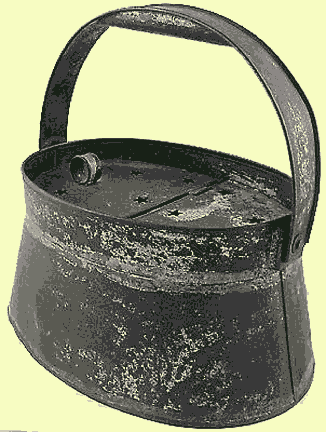 A
second example of a compressed air self-aerating model is the Air-Fed
Minnow Bucket made by the Air-Fed Manufacturing and Stamping Company of
Quincy, Illinois A brass air primp was attached to the outside of this
bucket. Made of galvanized steel with a green finish and an attractive
gold label, it came in two sizes, 8 and 10 quarts, from the 1920s
through the early 1930s. Today, one in very good condition would cost
$100 to $150. This Air-Fed Minnow Bucket has an interesting warning on
the label—“The air chamber in this bucket has been tested to 25 lbs.
Never pump it more than this amount of pressure. DO NOT FILL AT A
FILLING STATION. Test pressure after eight strokes of the pump.” A
second example of a compressed air self-aerating model is the Air-Fed
Minnow Bucket made by the Air-Fed Manufacturing and Stamping Company of
Quincy, Illinois A brass air primp was attached to the outside of this
bucket. Made of galvanized steel with a green finish and an attractive
gold label, it came in two sizes, 8 and 10 quarts, from the 1920s
through the early 1930s. Today, one in very good condition would cost
$100 to $150. This Air-Fed Minnow Bucket has an interesting warning on
the label—“The air chamber in this bucket has been tested to 25 lbs.
Never pump it more than this amount of pressure. DO NOT FILL AT A
FILLING STATION. Test pressure after eight strokes of the pump.”
Geuder, Pasachke and Frey Co. made Cream City buckets, some of the most
attractive minnow buckets ever produced. Early Cream City minnow buckets
are the most sought after. These were tin-plated and featured a japanned
finish with classic trade names such as Victor, Good Luck, Security,
Progress, Perfection, Favorite and Climax, and each
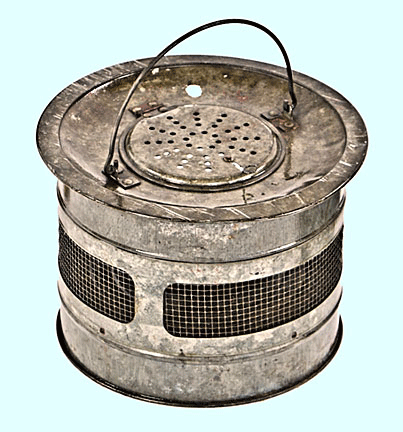 model
came with appealing Victorian designs and stenciling. Many of the
buckets came with the Cream City name, but the company shipped some to
customers who wanted only these special classic trade names on their
private-label buckets. Again, depending upon condition, some of the rare
early tinned Cream City buckets can sell for $200 to $300 and more. model
came with appealing Victorian designs and stenciling. Many of the
buckets came with the Cream City name, but the company shipped some to
customers who wanted only these special classic trade names on their
private-label buckets. Again, depending upon condition, some of the rare
early tinned Cream City buckets can sell for $200 to $300 and more.
Galvanized buckets started to gain popularity between 1910 and 1920.
Galvanizing is the coating of iron or steel with rust-resistant zinc,
generally by plunging the item into a bath of melted zinc. The rust
proofing characteristics of galvanized buckets lasted longer than
japanned tin-plated steel. Cream City eventually started making
galvanized buckets as well, and these were available in round and oval
shapes up to 20 quarts. Galvanized buckets generally came with
single-color black stencils with simpler designs. Their values run from
$50 to $100 depending upon condition and rarity of the model.
 The
Shakespeare Company of Kalamazoo, Michigan, also marketed minnow buckets
starting in 1916. Their extensive line of nine different styles appears
to have been made by Cream City. Six of the series were tin-plated steel
and japanned finished in dark green with gold striping, and three series
were painted galvanized steel. These early Shakespeare minnow buckets
are rare and sell for $100 to $300 based on condition. The
Shakespeare Company of Kalamazoo, Michigan, also marketed minnow buckets
starting in 1916. Their extensive line of nine different styles appears
to have been made by Cream City. Six of the series were tin-plated steel
and japanned finished in dark green with gold striping, and three series
were painted galvanized steel. These early Shakespeare minnow buckets
are rare and sell for $100 to $300 based on condition.
Individual blacksmiths and tinsmiths made copper minnow buckets for
local orders only. They can sell for $200 to $1,000, depending on their
condition.
Minnow buckets have quite the history, and the values keep going up all
the time, so collecting them can get pricey.
Split Cane Fishing Rods
While it may be a challenge to find a split-cane rod selling for $20 at
a garage sale, the availability of rods made by master rod makers has
increased over the past 20 years.
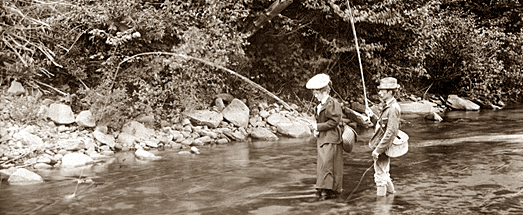
Split-cane rods have traditionally been made of bamboo from the Tonkin
region of China. Though not the only rod collected, mass produced
fiberglass or graphite rods have less value. Unfortunately, these types
of rods are only worth collecting if they belong to a famous person,
such as a U.S. President or a celebrity. Split-cane rods are in a whole
different category.
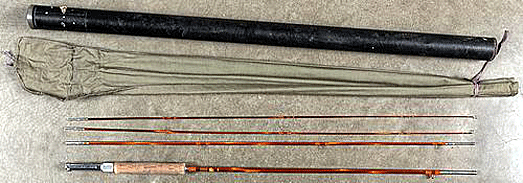
Canes rods made by such noted manufacturers as Phillipson, Garrison,
Payne or Leonard can sell for $6,000 to $7000 each. Those in good
condition but not previously owned by a noted personality sell for
$50-100 on the low side to $3,000 to $5,000 on the high side.

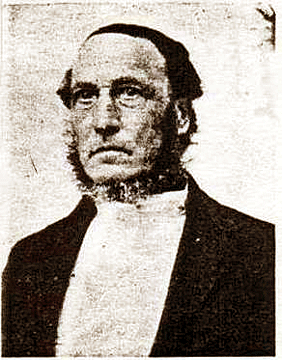 Split-cane
rods first appeared early to mid 19th century. However, historians
believe that the Chinese were gluing bamboo strips together to make rods
around 950 BCE. Versions of cane rods prior to the 19th century were
made from a solid piece of wood with little of the flexibility or
accuracy that could be obtained by gluing six triangular pieces of
bamboo or cane. Cane rod makers have long preferred Tonkin bamboo for
its lightness and strength. Some say it’s as strong as steel. Weight is
important to fisherman who may make 2,000 to 3,000 casts in a typical
day of fishing. Split-cane
rods first appeared early to mid 19th century. However, historians
believe that the Chinese were gluing bamboo strips together to make rods
around 950 BCE. Versions of cane rods prior to the 19th century were
made from a solid piece of wood with little of the flexibility or
accuracy that could be obtained by gluing six triangular pieces of
bamboo or cane. Cane rod makers have long preferred Tonkin bamboo for
its lightness and strength. Some say it’s as strong as steel. Weight is
important to fisherman who may make 2,000 to 3,000 casts in a typical
day of fishing.
Many of the rodmakers who became famous for their cane rods began in the
workshop of Hiram Leonard. Early on, the craft passed from master to
apprentice. Mass produced rods first appeared in the 1930s.
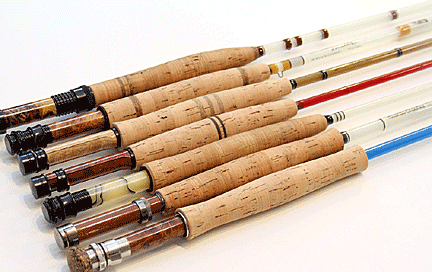
The introduction of tubular fiberglass in the 1950s and graphite rods a
decade later put an end to the making of split-cane rods by the 1970s.
<
Back to Antique Spotlight Archives
Next
Article >
|
